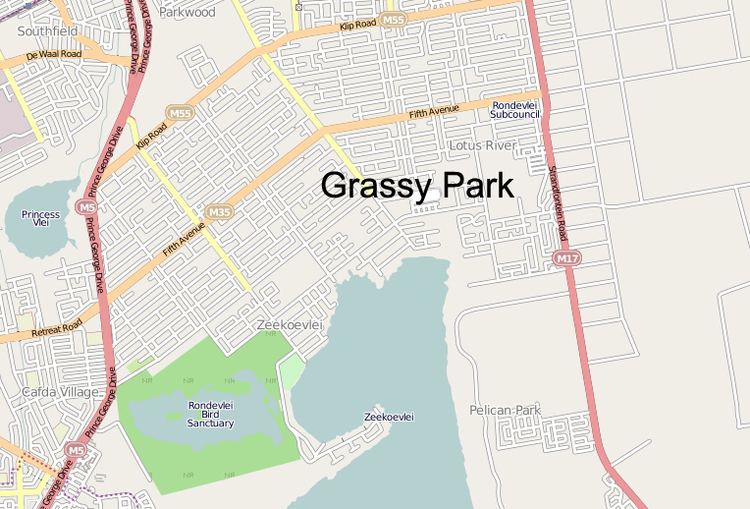Postal code (street) 7888 | Main Place Grassy Park PO box 7941 | |
 | ||
Grassy park south africa on bbc news 15 april 2009 hq
Grassy Park is a suburb in the Western Cape Province of South Africa, situated on the Cape Flats in the 021, also known as the City of Cape Town.
Contents
Grassy Park is home to some of the most diverse plant and wildlife as well as being almost completely surrounded by vleis and lakes. The most notable is the Rondevlei Nature Reserve home to a very shy hippopotamus, a few eland and many other smaller animals, who mainly come out at night. Rondevlei is also home to a healthy pelican community. Zeekoevlei is one of the many freshwater lakes in the district and home to a thriving community. A lesser known body of water is the Princess Vlei, which falls within the Ramsar Convention.
History
Described by some as "apartheid's dumping ground", from the 1950s the area became home to people the apartheid government designated as non-White. Race-based legislation such as the Group Areas Act and pass laws either forced non-white people out of more central urban areas designated for white people and into government-built townships in the Flats, or made living in the area illegal, forcing many people designated as Black and Coloured into informal settlements elsewhere in the Flats. The Flats have since then been home to much of the population of Greater Cape Town.
Grassy Park began to develop in the early 1900s on part of the Montagu's Gift estate north of Zeekoevlei. At that time, the area was rural, under the administration of the Divisional Council of the Cape. By 1920, the estate had 2000 residents. From 1923, it was represented on the Southern Civic Association.
Grassy Park was proclaimed a local area in 1935, which meant that the residents received municipal services, for which they paid higher rates. It was later incorporated into the South Peninsula Municipality in 1996, and into the City of Cape Town in 2000.
The apartheid regime in the mid- to late 1960s moved people classified as coloured or black into the township for low-income families. Originally called Koek se bos, or Cook's bush, the apartheid regime cleared tracks of land for the coloured people that lived in areas that were designated 'white areas' by the regime. All people deemed coloured or black were removed from areas including Bergvliet, Bishopscourt, Claremont, Constantia, Newlands, Rondebosch, District Six, Salt River, Tokai, Woodstock and Wynberg.
By the late 1980s and 90s, major areas of Grassy Park have deteriorated into urban ghettos. Gangsterism and drug abuse has increased and a number of informal settlements has sprung up in several areas. The area has seen constant fighting by the notorious Numbers gangs for control of drug supply.
Community projects
Cape Town Environmental Education Trust
Today
Grassy Park's main area is an intersection called "Busy Corner" at the intersection of 5th Avenue and Victoria Road. Here you will find a hub of small retail outlets, the local Library, Police Station, a transport interchange which connects Grassy Park to Mitchels Plein, Retreat and Wynberg, 3 of the main transport veins on the cape flats. The area has several primary and secondary schools and is home to the SPCA and LOFOB.
